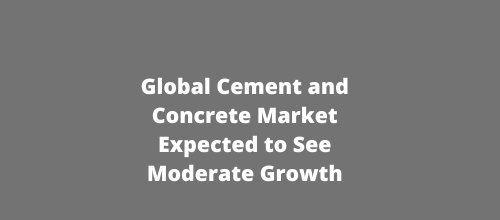Global Cement and Concrete Market Expected to See Moderate Growth

The global cement and concrete market continues to navigate a complex landscape shaped by macroeconomic uncertainties, shifting demand patterns, and speeding up sustainability imperatives. In 2024, the industry showed moderate growth despite ongoing headwinds, and early indicators in 2025 suggest cautious optimism, particularly in Asia and parts of the Middle East.
Global cement consumption edged up in 2024, largely driven by infrastructure development in emerging economies, where China remains the dominant player. However, its growth is plateauing because of real estate sector slowdowns and environmental regulations aimed at reducing carbon emissions from heavy industries.
India is emerging as a bright spot, with demand growth supported by government-led infrastructure programs such as “PM Gati Shakti” and affordable housing initiatives. Southeast Asia and Africa also show strong potential, benefiting from urbanisation and increasing investment in public infrastructure.
Developed markets, including the US and the EU, are seeing slower but steady growth. In the US, the Infrastructure Investment and Jobs Act continues to bolster demand, especially in roads, bridges, and transit projects. The European market remains stable, though stricter environmental compliance and rising energy costs are pressuring margins.
Sustainability remains at the forefront of industry transformation. Cement production accounts for about 7% of global CO₂ emissions, prompting a shift toward greener alternatives. Companies are increasingly investing in low-carbon cement blends, carbon capture and storage (CCS) technologies, and supplementary cementitious materials (SCMs) such as fly ash and slag.
In 2025, several major players, including Holcim, Heidelberg Materials, and CEMEX, expanded their portfolios of carbon-reduced concrete products. The uptake of these products is gaining traction in markets where environmental regulations or green building certifications drive demand.
Innovation is also shaping the competitive landscape. Advances in 3D concrete printing, AI-driven construction planning, and new curing technologies are enhancing efficiency, reducing waste, and lowering environmental footprints.
Consolidation activity has picked up, with regional and global players seeking synergies and market access. Notable deals in 2024 included acquisitions focused on vertical integration, especially in aggregates and ready-mix concrete, to shield margins from cost volatility.
In parallel, smaller local producers continue to operate in fragmented markets, particularly in Africa and Southeast Asia, where cost leadership often outweighs brand differentiation.
Despite the positive outlook, challenges persist. Energy price volatility, supply chain disruptions, and inflationary pressures continue to affect profitability. Environmental compliance costs are rising, particularly in Europe, and stricter carbon taxation could reshape cost structures further.
Adding to the complexity of the global trade environment are US tariffs on imported cement and related materials, which have created ripple effects across North American supply chains. These tariffs—part of a broader trade protection framework aimed at supporting domestic manufacturing—have led to higher input costs for US construction firms, particularly in states reliant on imports from Mexico, Canada, and Asia. While this has marginally benefited domestic producers by improving price competitiveness, it has also contributed to volatility in project timelines and budgeting, particularly for large-scale infrastructure and coastal urban developments.
Climate-related risks, such as extreme weather events, also pose operational challenges, while geopolitical tensions and trade restrictions may impact the flow of raw materials like gypsum and clinker.
The cement and concrete industry is expected to grow modestly over the next ten years, with growth skewed toward Asia-Pacific and Africa. Sustainability, innovation, and policy alignment will be key determinants of long-term competitiveness as the industry transitions toward a low-carbon future.
This article is based on our recently published report on The Global Cement and Concrete Market Outlook to 2035.
To learn more about the report please contact us at info@commodityinside.com
